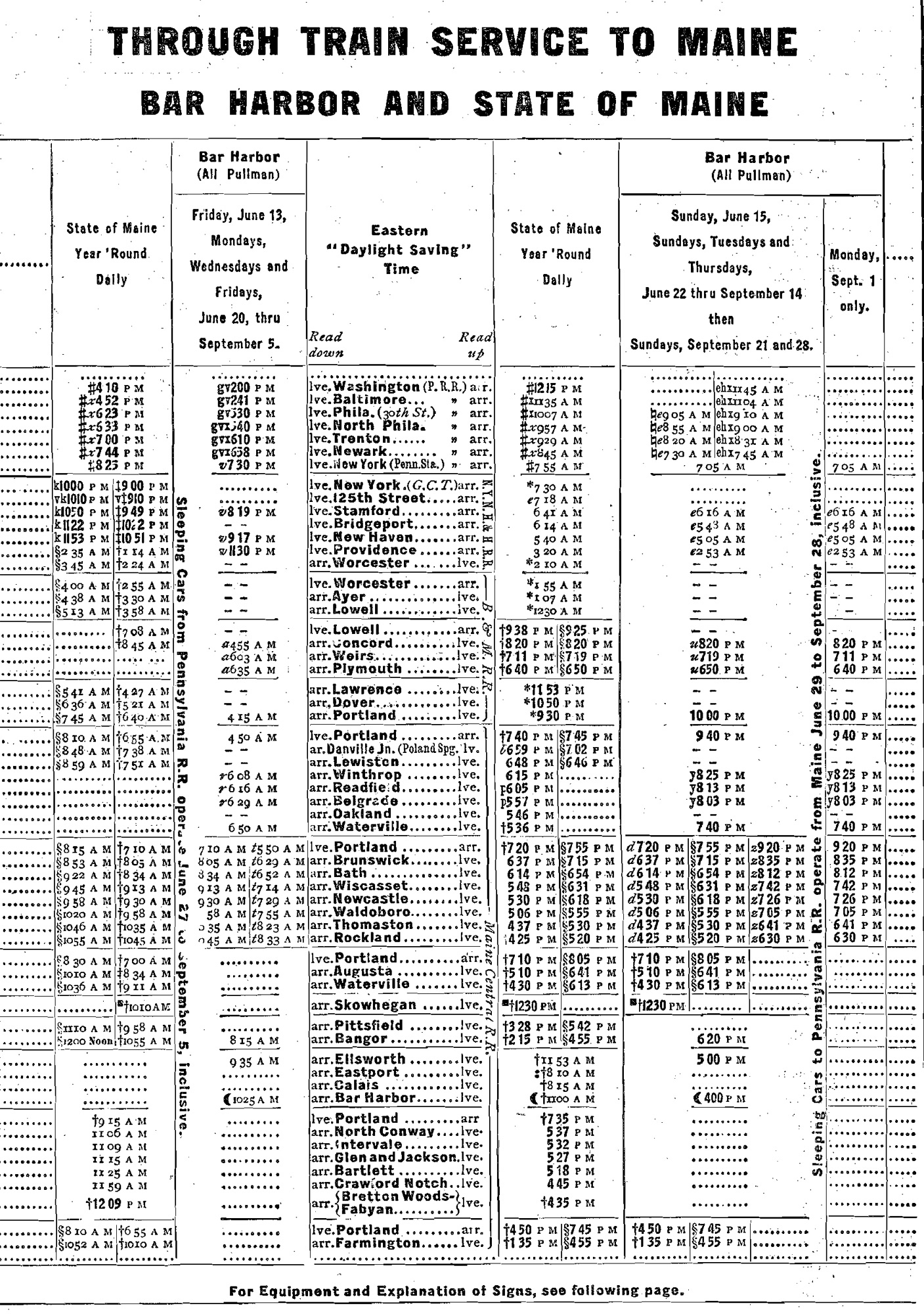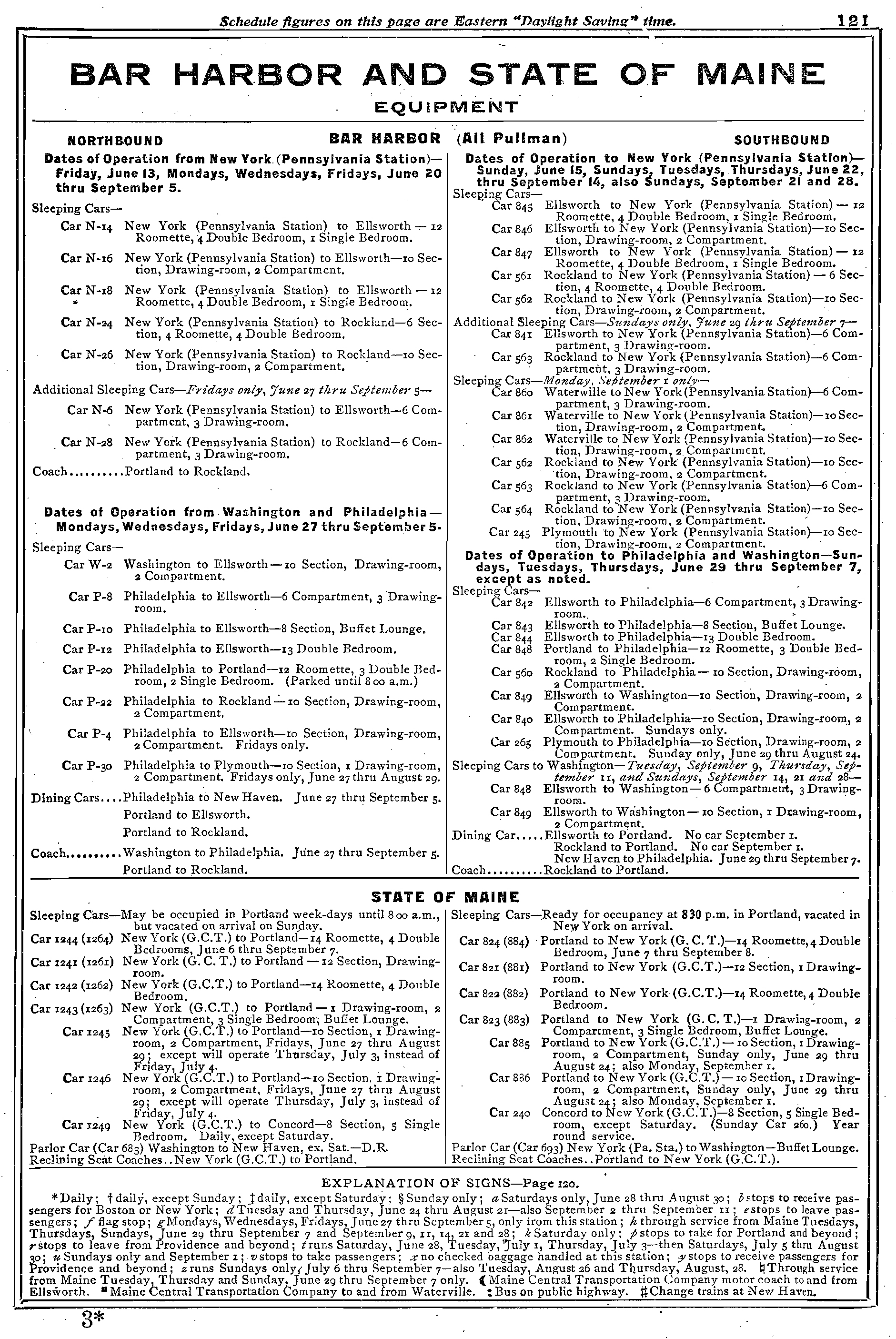"State Of Maine Express" (Train): Timetables, Consist, History
Last revised: September 15, 2024
By: Adam Burns
The State Of Maine Express was another of the many joint ventures carried out by the Boston & Maine and New Haven serving the populated coastal areas of northern New England.
It operated on a year-round schedule running an abbreviated routing in comparison to some of the region's more well-known trains. The overnight run, inaugurated in the early 20th century, interchanged in central Massachusetts and also had a daytime running-mate (which operated only during the warmer months).
The State Of Maine, as it was referred after World War II, survived until the early 1960s when lack of patronage and declining interest by the participating railroads resulted in its cancellation.
It is somewhat surprising, given New England's condensed nature, with large populations in relative close proximity, that so many first-class services were avaliable.
One could even book such accommodations to the northern reaches of Maine via Bangor & Aroostook's Potoland Special and Aroostook Flyer. It was certainly a different time in America.
History
If one lived in the Northeast/New England during the early 20th century virtually any town of notable size could be reached by rail. The on-board accommodations were equally impressive with comfy reclining seat coaches, full dining services, relaxing lounge cars, and Pullman sleepers.
Most of these trains were joint operations of the Pennsylvania, Boston & Maine, New Haven, and Maine Central. The PRR and New Haven connections were especially key as urbanites living in Washington, Baltimore, Philadelphia, New York, and Boston could reach the vacation resorts of northern New England.
The State Of Maine Express was one such train, operated by the B&M and New Haven connecting New York City (Grand Central Terminal) with Portland, Maine at a distance of 343 miles.
Timetable (August, 1952)

Accommodations
Interestingly, as Kevin Holland notes in his book, "Passenger Trains of New England, In The Streamline Era," occasionally Maine Central equipment could be found on consists north of Portland.
The New Haven and B&M interchanged all trains at Worcester, Massachusetts since separate Boston terminals precluded that city as an option. The Express ran essentially a truncated route of the seasonal East Wind (Washington - Bangor, Maine) but provided year-round service via an overnight schedule.
This meant sleepers and Pullmans were regularly in the consist. Heavyweights were generally the order of the day but during the streamlined era the train did carry some lightweight equipment as well.
Complete Consist (August, 1952)

According to Mr. Holland's book during the 1930s the eastbound (geographically northbound) State Of Maine Express offered Pullmans between New York-Portland, New York-Concord (New Hampshire), New York-Rockport (Massachusetts), New York-Portsmouth (New Hampshire), and New York-Rumford (Maine).
The westbound version provided the same service with additional Pullmans running between Plymouth-Philadelphia and Portland-Philadelphia via the Pennsylvania Railroad. Finally, coaches as well as a smoking car, were always provided between Portland and New York.
During the latter World War II era the train had a running-mate known as the Day Express. It operated only during the daylight hours and during the summer provided coach service and a diner north of New Haven.
Timetable (September 28, 1941)
| Read Down Time/Leave (Train #81/New Haven) | Milepost | Location | Read Up Time/Arrive (Train #82/New Haven) |
|---|---|---|---|
| 9:00 PM (Dp) | 0.0 | 7:15 AM (Ar) | |
| 9:10 PM (Dp) | 4.2 | 7:04 AM (Ar) | |
| 9:52 PM | 33.1 | 6:25 AM | |
| 10:23 PM | 55.6 | 5:57 AM | |
| 11:06 PM | 72.3 | 5:25 AM | |
| 12:11 AM | 123.1 | 4:16 AM | |
| 12:37 AM | 136.6 | 3:50 AM | |
| 1:31 AM | 169.4 | 3:01 AM | |
| 2:17 AM (Ar) | 195.4 | 2:15 AM (Dp) | |
| Time/Leave (Train #81/Boston & Maine) | Milepost | Location | Time/Arrive (Train #82/Boston & Maine) |
| 2:32 AM (Dp) | 195.4 | 1:30 AM (Ar) | |
| 3:16 AM (Ar) | 223.4 | 12:40 AM (Dp) | |
| 3:42 AM (Ar) | 239.6 | 12:07 AM (Dp) | |
| 4:18 AM (Ar) | 254.5 | 11:27 PM | |
| 4:36 AM | 261.4 | 11:09 PM | |
| 4:58 AM | 278.9 | 10:45 PM | |
| 5:16 AM | 295.6 | 10:22 PM | |
| F 5:46 AM | 313.4 | F 9:50 PM | |
| 5:55 AM | 318.5 | 9:40 PM | |
| 6:10 AM | 327.6 | 9:27 PM | |
| 6:35 AM (Ar) | 343.2 | 9:00 PM (Dp) |
Perhaps its most interesting feature was the use of Pullman sleepers as standard coaches, utilizing maximum efficiency of the cars that would otherwise sit dormant during the daylight hours between their nightly runs.
After 1948 the State Of Maine Express lost its latter designation and became known simply as the State Of Maine.
Its consist by 1955 still included several sleepers (as many as five on Fridays) along with a sleeper-lounge, a coach (an additional car ran on the weekends), and as many as five head-end cars (RPO, baggage, combine, storage-mail, and express car).
By this era, the once popular overnight train was losing favor as many elected to simply take their automobile or hop on a plane. This issue was made worse in the Northeast where cities were within close driving proximity from one another.
Final Years
One by one ,once popular trains like the East Wind, Bar Harbor Express, Flying Yankee, and others were dropped as ridership declined to the point it was no longer economical to continue.
Throughout the 1950s the Boston & Maine had been slashing services, hastened during the presidency of Patrick McGinnis who attempted to reduce operational losses through cutbacks, the new Rail Diesel Car (RDC), and lightweight trainsets.
Unfortunately, his attempts - and very poor management - failed in miserable fashion. As for the State Of Maine its end came in late 1960 when the train made its final run during October of that year.
Sources
- Holland, Kevin J. Passenger Trains Of Northern New England, In The Streamline Era. Lynchburg: TLC Publishing, 2004.
- Lynch, Peter E. New Haven Passenger Trains. St. Paul: MBI Publishing Company, 2005.
- Schafer, Mike. Classic American Railroads. Osceola: MBI Publishing, 1996.
- Schafer, Mike. More Classic American Railroads. Osceola: MBI Publishing, 2000.
Recent Articles
-
Rio Grande 2-8-2 Locomotives (K-36): Specs, Roster, Photos
Apr 15, 25 11:09 AM
The Rio Grande's K-36 2-8-2s were its last new Mikados purchased for narrow-gauge use. Today, all but one survives. -
Rio Grande 2-8-2 Locomotives (Class K-28): Specs, Roster, Photos
Apr 14, 25 10:24 PM
Rio Grande's Class K-28 Mikados were its newest narrow-gauge steam locomotives since the Mudhens of the early 1900s. Today, three survive. -
Rio Grande K-27 "Mudhens" (2-8-2): Specs, Roster, Photos
Apr 14, 25 05:40 PM
Rio Grande's Class K-27 of 2-8-2s were more commonly referred to as Mudhens by crews. They were the first to enter service and today two survive.


